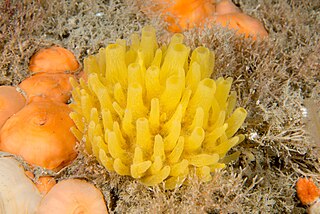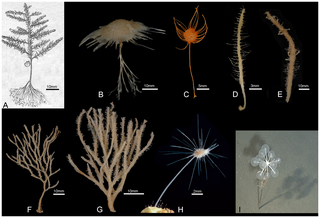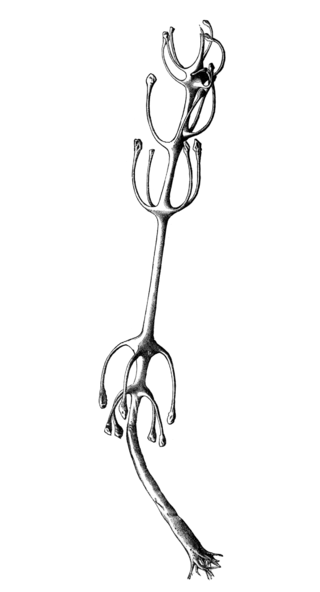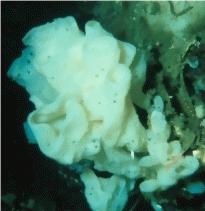
Cladorhiza is a genus of carnivorous sponges, comprising around 40 species found in oceans around the world. Cladorhiza is the type genus of the family Cladorhizidae.

Polymastia is a genus of sea sponges containing about 30 species. These are small to large encrusting or dome-shaped sponges with a smooth surface having many teat-shaped projections (papillae). In areas of strong wave action, this genus does not grow the teat structures, but instead grows in a corrugated form.

Chondrocladia is a genus of carnivorous demosponges of the family Cladorhizidae. Neocladia was long considered a junior synonym, but has recently become accepted as a distinct genus.

Chondrocladia lyra, also known as the lyre sponge or harp sponge, is a species of carnivorous deep-sea sponge first discovered off the Californian coast living at depths of 10,800–11,500 feet (3,300–3,500 m) by Welton L. Lee, Henry M Reiswig, William C. Austin, and Lonny Lundsten from the Monterey Bay Aquarium Research Institute (MBARI).

Cladorhizidae is a family of carnivorous demosponges found in deep-sea environments worldwide. These sponges are known for their unique feeding structures and predatory behavior, as they capture and consume small animals such as crustaceans.
Gregor Michel Cailliet is an American scientist who studies the ecology of marine fishes. He is professor emeritus at Moss Landing Marine Laboratories, part of The California State University, having officially retired in 2009.

Chondrocladia concrescens is a species of deep-sea carnivorous sponge in the family Cladorhizidae. It is commonly known as the "ping pong tree sponge" due to its distinctive tree-like shape with multiple branches. The species is found in the eastern Pacific Ocean and can grow up to one meter in height.
Cladorhiza evae is a species of carnivorous sponge native to hydrothermal vents in the Gulf of California.
Cladorhiza inversa is a species of sponge in the taxonomic class Demospongiae. The body of the sponge consists of a spicule and fibers and is water absorbent.
Cladorhiza segonzaci is a species of sponge in the taxonomic class Demospongiae. The body of the sponge consists of a spicule and fibers and is water absorbent.
Axoniderma is a genus of carnivorous demosponges in the family Cladorhizidae.
Claviscopulia is a genus of glass sponge in the family Farreidae.
Jean Vacelet is a French marine biologist who specialises in the underwater fauna of the Mediterranean. After earning his licence at the Faculté des Sciences de Marseille and learning to dive in 1954, he specialised in the study of sponges at the Marine station of Endoume, and there he has stayed faithful to both sponges and place for more than half a century. His research has included all aspects of sponges: taxonomy, habitat, biology, anatomy, their bacterial associations, and their place in the evolution of multi-celled animals. He has studied them not only in the Mediterranean but in the Indian Ocean and the Pacific. Exploration of underwater grottoes, together with Jacques Laborel and Jo Hamelin, revealed the existence of sponges dating from very ancient geological periods and the unexpected existence of carnivorous sponges, and surprisingly, the grottoes in some ways mimicked life at much greater depths.
Michelle Kelly, also known as Michelle Kelly-Borges, is a New Zealand scientist who specialises in sponges, their chemistry, their evolution, taxonomy, systematics, and ecology.

Abyssocladia is a genus of the family Cladorhizidae, a family of carnivorous sponges. It is made up of at least 39 species found in oceans all over the world.

Atlantisella is a genus of glass sponges (Hexactinellids) belonging to the family Euplectellidae, first described in 2002 by Konstantin Tabachnick.
Axoniderma australis is a species of demosponge in the family Cladorhizidae. It is known from type specimens found off the coasts of Tasmania and New South Wales.
Axoniderma hubbsi is a species of demosponge in the family Cladorhizidae. It is known from type specimens found in the northeast Pacific Ocean.
Axoniderma kensmithi is a species of demosponge in the family Cladorhizidae. It is known from type specimens found in the Pacific Ocean off the coast of California.
Axoniderma mexicana is a species of demosponge in the family Cladorhizidae. It is known from type specimens found around Mexico.







